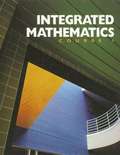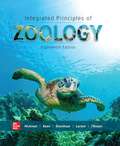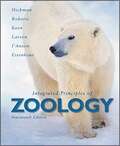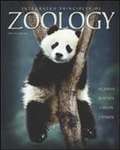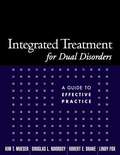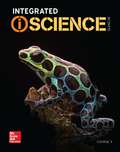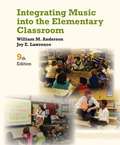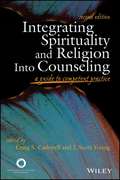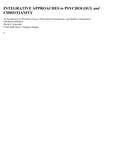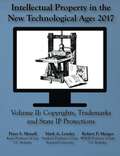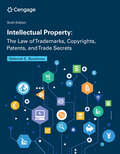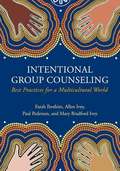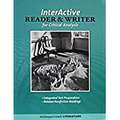- Table View
- List View
Integrated Mathematics, 1
by Timothy D. Kanold Edward B. Burger Juli K. DixonNIMAC-sourced textbook
Integrated Mathematics: Course 1
by Richard J. Klutch Elden B. Egbers Douglas R. Bumby Donald W. CollinsThis book is all about operations, numbers, algebra, formulas, inequalities, geometry, measurement, polynomials, factoring and probability.
Integrated Mathematics: Course 3 (Second Edition)
by Ann Xavier Gantert Edward P. KeenanThis Second Edition is offered to help students comprehend, master, and enjoy mathematics from an integrated point of view.
Integrated Mathematics: Course I (Third Edition)
by Isidore Dressler Edward P. KeenanIntegrated Mathematics: Course 1, Third Edition, is a thorough revision of a textbook that has been a leader in presenting high school mathematics in a contemporary, integrated manner.
Integrated Physics and Chemistry (1st edition)
by Tom HsuThis book gives teens a thorough grounding in basic chemistry and physics. Science concepts are repeated in different ways throughout the sections, and content-rich illustrations, numerous charts, graphs, and data tables assist them in grasping the subject matter
Integrated Physics+Chemistry
by Charles William Mclaughlin Marilyn Thompson Margaret KilgoNIMAC-sourced textbook
Integrated Principles Of Zoology
by Allan Larson Cleveland P. Hickman David J. Eisenhour Susan L. Keen Helen I'AnsonA comprehensive text covering biological principles, molecular genetics, evolution, diversity, and anatomy and physiology. Each chapter of the book has been fully revised and include colour illustrations, tables and figures.
Integrated Principles of Zoology
by Cleveland Hickman Jr.Emphasizing the central role of evolution in generating diversity, this best-selling text describes animal life and the fascinating adaptations that enable animals to inhabit so many ecological niches. Featuring high quality illustrations and photographs set within an engaging narrative, Integrated Principles of Zoology is considered the standard by which other texts are measured. With its comprehensive coverage of biological and zoological principles, mechanisms of evolution, diversity, physiology, and ecology, organized into five parts for easy access, this text is suitable for one- or two-semester introductory courses.
Integrated Principles of Zoology (12th edition)
by Allan Larson Larry S. Roberts Cleveland P. Hickman Jr. Helen L. AnsonAn introductory text emphasizing evolutionary principles and zoological investigation. Part I explains living systems, and the chemistry and origins of life. Part II focuses on reproduction, development, genetics, and evolution. Part III surveys the animal phyla and the animal-like protista. Part IV compares functional systems of animals, and Part V covers ecology. Features color photos, key terms, chapter summaries and review questions, plus a glossary and a historical appendix. This tenth edition offers a three-column design and increased coverage of environmental issues.
Integrated Science (5th Edition)
by Bill W. Tillery Eldon D. Enger Frederick C. RossTillery (Arizona State U. ), and Eldon D. Enger and Frederick C. Ross (both of Delta College) present a straightforward, easy-to-read, but substantial introduction to the fundamental behavior of matter and energy in living and nonliving systems. Intended for the non-science major, the 27 chapters introduce basic concepts and key ideas while providing opportunities for students to learn reasoning skills and a new way of thinking about their environment.
Integrated Science, Course 1-2
by Kenneth R. Miller Joseph Levine Edward J. Tarbuck Frederick K. Lutgens Dennis Tasa Paul G. Hewitt Edward A. Keller Robert H. BlodgettNIMAC-sourced textbook
Integrated Science, Course 3-4
by John Suchocki Kenneth R. Miller Joseph Levine Edward J. Tarbuck Frederick K. Lutgens Dennis Tasa Paul G. Hewitt Edward A. Keller Suzanne Lyons Jennifer Yeh Robert H. BlodgettNIMAC-sourced textbook
Integrated Treatment for Dual Disorders: A Guide to Effective Practice
by Robert E. Drake Kim T. Mueser Kim Tornvall Mueser Lindy Fox Douglas L. NoordsyThis comprehensive clinical handbook provides virtually everything needed to plan, deliver and evaluate effective treatment for persons with substance abuse problems and persistent mental illness. From authors at the forefront of the dual disorders field, the book is grounded in decades of influential research. Presented are clear guidelines for developing integrated treatment programmes, performing state-of-the-art assessments, and implementing a wide range of individual, group and family interventions. Also addressed are residential and other housing services, involuntary interventions, vocational rehabilitation, and psychopharmacology for dual disorders. Throughout, the emphasis is on workable ways to combine psychiatric and substance abuse services into a cohesive, unitary system of care. The volume contains all needed assessment forms, treatment planning materials and client handouts, most of which include permission to photocopy.
Integrated iScience, Course 1
by McGraw-Hill Education StaffIntegrated iScience blends life, earth, and physical science topics in three courses, specific to each grade. Integrated iScience Course 1 focuses on the methods of science and covers topics in life, earth, and physical science. Units include: The Nature of Science, Exploring Life, Understanding Matter, and Understanding Energy. The text's pedagogy (chapter outlines, core concept maps, and overviews) reveals how the science disciplines are interrelated and integrated throughout the text. It continues to introduce basic concepts and key ideas while providing opportunities for students to learn reasoning skills and a new way of thinking about their environment. iScience meets students where they are through engaging graphic novel-style features and thought-provoking questions that encourage them to relate the science concepts to the world around them. The inquiry-based 5E lesson cycle provides active, hands-on explorations of the concepts. Includes: Integrated iScience Course 1 Print Student Edition
Integrating Music into the Elementary Classroom
by William M. Anderson Joy E. LawrenceThe market-leading text for the Elementary School Music Methods course, INTEGRATING MUSIC INTO THE ELEMENTARY CLASSROOM was the first to emphasize the theme of integrating music throughout the school day. Anderson and Lawrence show future educators how to make music an effective part of the entire elementary curriculum. The text introduces songs, instruments, sources of age-appropriate music, and methods of making music in a multicultural environment -- making it perfect for students with no prior knowledge of music fundamentals. With easy techniques for teaching young children how to sing, play instruments, move to music, create music, listen to music, and understand music, this text relates music to all subject areas. Notably, the authors provide sample lesson plans for kindergarten through sixth grade, along with more than 150 songs from different cultures and historical periods.
Integrating Spirituality and Religion Into Counseling: A Guide to Competent Practice
by Craig S. Cashwell J. Scott YoungIn this book, experts in the field consider how spiritual and religious issues can be successfully incorporated into counseling in a manner consistent with client beliefs and practices. Designed as an introductory text for counselors-in-training and clinicians, it describes the knowledge base and skills necessary to effectively engage clients in an exploration of their spiritual and religious lives to further the therapeutic process.
Integrative Approaches to Psychology and Christianity: An Introduction to Worldview Issues, Philosophical Foundations, and Models of Integration
by David N. EntwistleSince the first edition of Integrative Approaches to Psychology and Christianity was published in 2004, this has become the standard textbook on the topic. Now in its fully revised fourth edition, Dr. Entwistle’s book elucidates historical, philosophical, and practical issues in the integration of psychology and Christianity. <p><p>As in previous editions, the current text provides an introduction to many of the worldview issues and philosophical foundations that frame the relationship of psychology and theology, includes scholarly reflection on the integration literature, and surveys six models of possible relationships between psychology and Christianity, ranging from those that are completely opposed to either religion or psychology, to intermediate models that assert that some limited interaction between them is possible, to viewpoints which suggest that a Christian worldview approach can be used to provide a context for exploring areas of overlapping interest between psychology and Christianity. <p><p>The current edition considers recent advances in both Catholic and Protestant thinking on integration, including contemporary questions about what evangelicalism is (and is not) that shape evangelical reactions to the integration debate. New content ranges from information about the contrasting views of Tertullian and Augustine, to insights from contemporary psychology about factors that adversely affect the quality and reliability of human thinking, to how conflict over COVID-19 has entered contemporary religious debate. <p><p>The book is designed to help readers become aware of the presuppositional backdrops that each of us brings to these issues. Questions at the end of each chapter are included to help readers evaluate both the material and their own burgeoning approach to integration. This book is ideal as a textbook for students of psychology and other behavioral and social sciences (social work, sociology, theology, counseling, pastoral counseling) at both the graduate and undergraduate level. It is also written for the broader readership of psychologists, counselors, pastors, and others who are interested in integration.
Intellectual Property in the New Technological Age: Copyrights, Trademarks and State IP Protections
by Mark A. Lemley Peter S. Menell Robert P. MergesIntellectual Property in the New Technological Age provides an in-depth survey of the rapidly evolving field of intellectual property law. Volume I covers philosophical perspectives, trade secret law, and patent law. Volume II covers copyright law, trademark law, and state intellectual property law protections.
Intellectual Property: The Law of Trademarks, Copyrights, Patents, and Trade Secrets
by Deborah E. BouchouxMaster the complexities of modern intellectual property (IP) law with Bouchoux’ INTELLECTUAL PROPERTY: THE LAW OF TRADEMARKS, COPYRIGHTS, PATENTS, AND TRADE SECRETS, 6E. Comprehensive yet reader-friendly, this edition addresses current trends and the latest developments in the field, including technological innovations, intellectual property in the digital age, the role of the Internet and the impact of the pandemic on IP. This edition provides sample agreements, forms, checklists of paralegal tasks and statutes to help you in practice. Updated case studies as well as excerpts of real cases highlight interesting issues, such as the ability to copyright the Batmobile or tattoos, the Google vs. Java battle or the suit against Stephen King. New learning features help you prepare for a successful career as a paralegal, while new activities reflect real business assignments to ensure you are ready for success in today's actual legal practice.
Intensified Algebra I, Student Activity Book, Volume 1: Linear Functions and their Foundations
by Agile MindThis volume includes four of eight units that make up the 2014-2015 edition of the Intensified Algebra I Student Activity Book.
Intentional Group Counseling: Best Practices for a Multicultural World
by Paul Pedersen Mary Bradford Ivey Allen Ivey Farah IbrahimThe text presents students with the latest research in applied psychology and group counseling, and also breaks down the complex art of leadership into individual skills using the Microskills approach. Embracing an experiential learning framework, students are guided through the practical application of learned Microskills in real-world group settings to further develop their competencies within dynamic environments.
InterActive Reader & Writer for Critical Analysis, Grade 8
by Arthur N. Applebee Jim Burke Janet AllenNIMAC-sourced textbook

